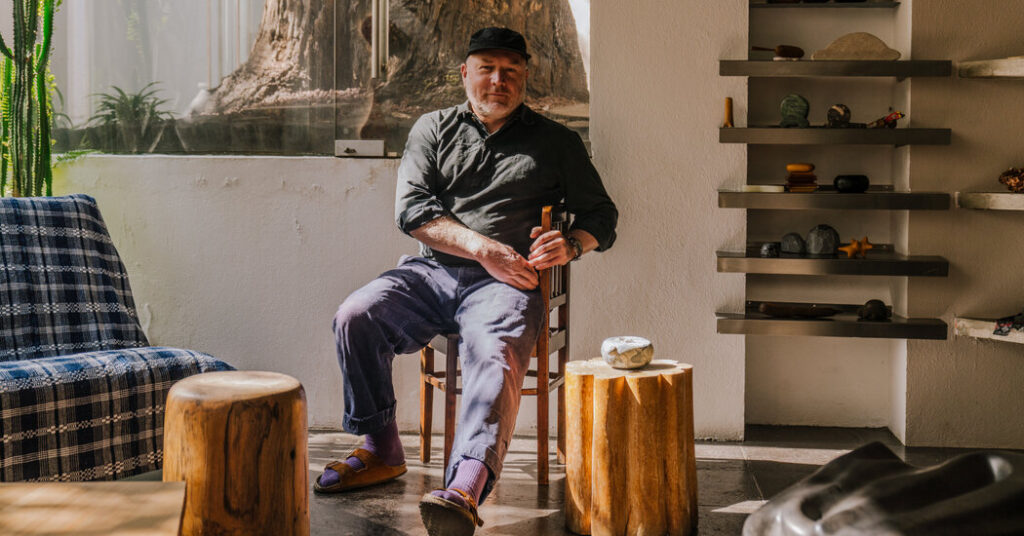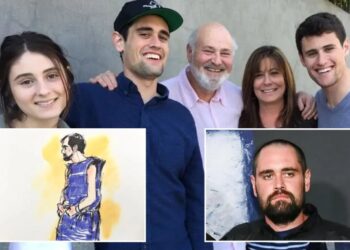The State Department announced on Monday that the American sculptor Alma Allen, now based in Mexico, would represent the United States at next year’s Venice Biennale, ending a chaotic process that had led some to fear that the United States would not find an artist to participate in the art world’s version of the Olympics.
Allen, 55, will exhibit nearly 30 sculptures in a show organized by the curator Jeffrey Uslip and called “Alma Allen: Call Me the Breeze.” Allen’s selection was delayed significantly by an overhaul of the selection committee, by the earlier choice of another artist whose selection was ultimately withdrawn and by the longest government shutdown in U.S. history.
In an interview, Allen said that he had not applied for the commission but that Uslip, whom he had never met, had called him in October to ask if he would accept the selection, one of the highest distinctions in the art world. Allen, who was raised in Utah, accepted, without hesitation, even as some in the art world warned him not to associate himself with a presidential administration that they see as hostile to the art world.
Most of what Allen will exhibit at the Venice Biennale, which will begin in May, will not be new work, but he does plan to cover the costs to create a few new sculptures, as he has throughout his career. The State Department, which typically provides only a small portion of the money needed to exhibit at the Venice Biennale, will cover the cost of shipping and other transportation.
“I had been told that I was approved by the State Department before I was asked,” said Allen, speaking from his home outside Mexico City, where he has lived since 2017. “They have been great so far and have given me total freedom in what I want to make.”
As a self-taught artist with a sparse history of museum exhibitions in the United States, Allen is not a typical candidate for the U.S. Pavilion, a 1930 Palladian-style building that occupies one of the most visible sites at the Venice Biennale. Other artists to represent the United States have included prominent names like Robert Rauschenberg, Ed Ruscha, Jenny Holzer, Jasper Johns and Simone Leigh.
Allen’s most recent solo show was in 2023 at the Museo Anahuacalli in Mexico City. His last major showcase in the United States came in 2022, when he presented a single sculpture at Rockefeller Center. This year, he had a series of sculptures installed on Park Avenue. He was also in the Whitney Biennial in 2014.
Alma said that his galleries, Mendes Wood and Olney Gleason, asked him not to accept the Venice Biennale commission and that when he did, they dropped him. They refused to represent him, he said, if he was going to associate himself with the Trump administration. (President Trump’s policies have disrupted grants from agencies including the National Endowment for the Arts and the National Endowment for the Humanities, and his administration has pressured museums and other cultural institutions across the country to adjust exhibits that it found objectionable.)
Both galleries told The New York Times that they were no longer working with Allen, but they declined to explain why.
“Nobody has asked me to do anything in service of the Trump administration,” said Allen, who pointed out that artists including Leigh and Mark Bradford had participated in the Venice Biennale during Mr. Trump’s first term.
“I feel like I’m representing my country,” he said, adding that his former galleries were “afraid of something they can’t really define.”
An Altered Process
The State Department has typically outsourced the process of selecting a U.S. artist for the Venice Biennale to the National Endowment for the Arts, which convenes an advisory committee of museum curators and art historians tasked with making the selection from a list of proposed names.
Winning proposals have often included a partnership between an artist and nonprofit organizations willing to organize the exhibition and raise funds for it. In 2024, the artist Jeffrey Gibson, for instance, worked with the contemporary art institution SITE Santa Fe and the Portland Art Museum on his exhibition, which was supported by a $5 million budget. (That year, the State Department contributed $375,000, or roughly 7.5 percent of the total cost.)
But the National Endowment for the Arts did not participate in this year’s selection process, a decision that a spokeswoman for the endowment said had been “driven by current time constraints and staffing transitions” at both the N.E.A. and the State Department.
Instead, the Bureau of Educational and Cultural Affairs at the State Department took the lead on organizing the application process, which started later than usual, included unnamed (and an unknown number of) “experts in American art” and ultimately missed its deadline to make a decision at the end of September.
A spokeswoman for the State Department did not respond to questions about its process this year.
It is not clear how Uslip became involved with the State Department on the project. He had been the deputy director of exhibitions and programs at Contemporary Art Museum St. Louis until he resigned in 2016. An exhibition he organized that year on the artist Kelley Walker included images of police brutality toward civil rights protesters, silk-screened with smeared white and dark chocolate, according to a report in Artnet in 2016. Some members of the Black community in St. Louis found the images to be racist and that led to calls for his dismissal.
Most recently, he was a co-curator of the Malta Pavilion at the 2022 edition of the Venice Biennale.
Uslip did not respond to requests for comment.
Last month, State Department officials thought they were ready to announce a winner: Robert Lazzarini, another artist without name recognition.
Lazzarini had been a long-shot candidate, with little exhibition history in American museums since his breakthrough in the early 2000s. Elements of his proposal that he uploaded to his Instagram account showed squiggly American flags and a crumpled sculpture of an eagle. The State Department informed him in September that he had been chosen, according to The Washington Post.
But then a funding agreement for the exhibition between the State Department and the University of South Florida collapsed, according to John Ravenal, the curator who proposed the Lazzarini exhibition. The State Department withdrew Lazzarini’s commission before it was announced publicly.
It was “two bureaucracies failing to mesh,” Ravenal told The Post this month.
Shortly afterward, reports circulated that the State Department had instead selected Allen to represent the United States, even though the sculptor had not officially applied. At the time, the federal government was shut down, and the State Department did not announce the selection.
Picking Up the Pieces
In the aftermath of the failed Lazzarini commission, a new nonprofit, American Arts Conservancy, has taken the lead on fund-raising efforts. This is partly because philanthropic partners like the Ford Foundation decided not to support the United States’ participation in the Venice Biennale this year, as they have before.
The American Arts Conservancy said it was raising money for “a once-in-a-generation opportunity to restore America’s artistic presence abroad while realigning its foundations at home.”
According to the group’s website, Uslip serves on its board of directors.
American Arts Conservancy, which is based in Florida, was founded this year, according to public filings with the Internal Revenue Service. Its executive director, Jenni Parido, ran a pet food store in Tampa, Fla., for almost nine years, according to her LinkedIn profile.
“Alma Allen embodies the qualities of America’s best and brightest; he is a self-taught American success story,” Parido said in a news release, which names as a commissioner of the exhibition. “The American Arts Conservancy is proud to share his work with audiences from around the world at the next Venice Biennale.”
Allen said he was not focused on the details surrounding the financing of his exhibition. He recently expanded his studio near Mexico City to include 15 employees who will help prepare for the Venice Biennale. As inspiration, he cited a range of sources, including the French sculptor Louise Bourgeois, the artist Martin Puryear and the giant Olmec heads of ancient Mexico.
“Sometimes my work is dismissed as being abstract or apolitical,” he said. “But it represents the experiences that I have had in my life.”
Allen left his hometown, Heber City, Utah, as a teenager and was homeless off and on for many years, taking odd jobs like cleaning truck-stop toilets and blast furnaces, gutting chickens and washing dishes. When he landed in New York in the early 1990s, he worked construction jobs and whittled carvings in his spare time until a truck ran over him at the Brooklyn Navy Yard in 1994, severely injuring him.
“I was totally desperate,” he said. “I had no money. I was on crutches. A Dominican bakery in Williamsburg was giving me rice and beans on credit.”
While still on crutches, he made his way to SoHo, grabbed an ironing board and created a stand to sell his whittled sculptures.
“In a couple of weeks, I sold everything,” Allen said. “It changed my life.”
He said the exhibition at the U.S. Pavilion would be an extensive survey of his career. It will include, he said, a large-scale work for the pavilion’s courtyard.
“Getting to exhibit at the pavilion and represent America — there is a lot of power to that,” Allen said. “I have learned that to do things in life, I had to be willing to take risks.”
“This is how my life has gone,” he added. “There are moments of luck and moments of difficulty. And sometimes they happen at the same time.”
Zachary Small is a Times reporter writing about the art world’s relationship to money, politics and technology.
The post Alma Allen, American Sculptor, Is Selected for Venice Biennale appeared first on New York Times.




